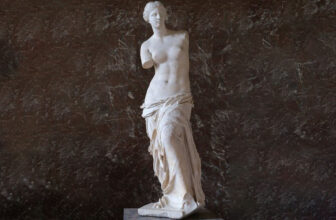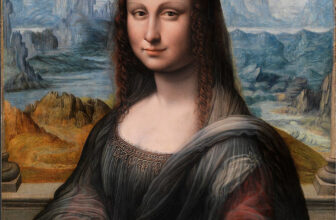The Mona Lisa Worth Today
One question that many people have about the Mona Lisa is, how much is it worth?
It is difficult to put a precise on how much is the Mona Lisa worth because the painting is so unique and valuable that it is unlikely to ever be sold. The Mona Lisa is currently owned by the French government, and it is on permanent display at the Louvre Museum in Paris. The painting is considered priceless, and it is estimated to be worth well over a billion dollars.
However, in the past, there have been attempts to buy the Mona Lisa, and there have also been auctions of other Leonardo da Vinci paintings that can give us an idea of how much is the Mona Lisa worth if it were ever sold.
The highest price ever paid for a Leonardo da Vinci painting is $450 million, which was for Salvator Mundi, a painting of Jesus Christ that was sold at a Christie’s auction in 2017. The buyer was reportedly a Saudi Arabian prince. Before that, the highest price ever paid for a Leonardo da Vinci painting was $59 million for The Last Supper, which was sold in 2001.
There have been a few instances in the past where someone has tried to buy the Mona Lisa. The most famous attempt was in 1911 when a former employee of the Louvre stole the painting and attempted to sell it to an art dealer in Italy. The thief was caught, and the painting was returned to the Louvre. In another instance, in 1962, an American oil tycoon named Armand Hammer offered to buy the Mona Lisa for $50 million. However, the French government refused the offer, and the painting remained in the Louvre.
Given the historical and cultural significance of the Mona Lisa, it is unlikely that it will ever be sold. However, it is interesting to speculate on how much is the Mona Lisa worth if it were to be sold. Based on the prices paid for other Leonardo da Vinci paintings and the uniqueness and cultural value of the Mona Lisa, it is safe to say that the painting would be worth well over a billion dollars.
How Much Is The Mona Lisa Worth in 2025
The Mona Lisa, painted by Leonardo da Vinci, is considered priceless due to its immense cultural, historical, and artistic significance. However, experts have occasionally speculated on its monetary value.
In 1962, the Mona Lisa was insured for $100 million, making it the most valuable painting in the world at the time. Adjusted for inflation, this value would exceed $1 billion in 2024. Some art experts believe that if the Mona Lisa were ever sold on the open market (which is highly unlikely, as it is owned by the French government and housed in the Louvre Museum), it could fetch several billion dollars, potentially making it the most expensive artwork ever sold.
However, because it is a national treasure and legally classified as part of France’s inalienable cultural heritage, it cannot be sold, making any price purely hypothetical.
Why Is the Mona Lisa So Expensive?
The Mona Lisa is priceless for many reasons, historical, artistic, cultural, and symbolic. But if we were to assign it a monetary value, it would likely be the most expensive artwork in the world. Here’s why:
1. Rarity and Irreplaceability
Unlike other luxury goods, cars, watches, jewelry, there is only one Mona Lisa. It cannot be replicated, and no matter how skilled a forger might be, a copy will never carry the same weight or value as the original. This uniqueness is fundamental to its worth.
2. Historical Importance
Leonardo da Vinci is one of the greatest minds of all time, and the Mona Lisa is widely considered his magnum opus. It’s not just a painting; it’s a historical artifact. Owning it would be like owning the original Declaration of Independence or the Rosetta Stone. That kind of historical importance adds immeasurable value.
3. Global Recognition
The Mona Lisa is one of the most recognizable images on the planet. It has been referenced in films, songs, advertisements, and literature. This level of fame transforms it from an artwork into a cultural icon. The more something is embedded in the public consciousness, the more value it accrues.
4. Security and Insurance
In 1962, the Mona Lisa was insured for $100 million for a temporary exhibition in the U.S. Adjusted for inflation, that’s more than $900 million today. However, the Louvre has since decided not to insure the painting at all because its value is considered incalculable. Any number would fall short of its true cultural and artistic worth.
Can a Billionaire Buy the Mona Lisa?
In short: no, a billionaire cannot buy the Mona Lisa, not even the richest person on Earth. While it’s tempting to think that immense wealth can purchase anything, the Mona Lisa is not for sale. Here’s why:
1. Ownership by the French Government
The Mona Lisa is publicly owned by the French Republic and is held in trust by the Louvre Museum. It is protected under French heritage law, which means it is considered a national treasure. National treasures cannot be sold or exported outside of France under current legislation.
2. Cultural and Political Symbol
The painting is more than just a masterpiece; it’s a symbol of France’s cultural legacy. Selling it would provoke immense public outcry and political controversy. It would be akin to selling the Eiffel Tower. Even if a government were inclined to raise funds by selling cultural property (which France has never considered seriously), the Mona Lisa would be untouchable.
3. International Backlash
Art of this caliber doesn’t just belong to one country; it belongs to the world. The United Nations and various international cultural bodies would likely intervene or at least issue strong objections to any proposed sale. Its sale would set a dangerous precedent and could destabilize international agreements on cultural preservation.
Why Is the Mona Lisa So Valuable?
Value, in the world of art, isn’t just about market price, it’s also about meaning, influence, and impact. The Mona Lisa’s value can be broken down into several dimensions:
1. Artistic Innovation
Da Vinci’s innovations in technique, especially his use of sfumato, his mastery of anatomy, and his realistic portrayal of emotion, were groundbreaking. The painting’s composition, where the subject seems to watch the viewer from any angle, was unheard of at the time and continues to inspire artists today.
2. Mystery and Intrigue
The identity of the woman in the painting, traditionally believed to be Lisa Gherardini, the wife of a Florentine merchant, is still debated. The ambiguity of her smile and expression adds to the painting’s allure. People are drawn to mysteries, and the Mona Lisa offers one that has endured for centuries.
3. Cultural Capital
Owning a famous painting increases the cultural capital of a museum or collection. But in the Mona Lisa’s case, it defines the museum. The Louvre receives millions of visitors every year, many of whom come specifically to see the painting. It’s a powerful economic and cultural asset, driving tourism and revenue.
4. Historical Events
Its theft in 1911, recovery in 1913, and subsequent travels have only added to its mystique. The publicity surrounding these events made the Mona Lisa a household name. It became more than a painting; it became a legend.
Could It Ever Be Sold?
Theoretically, any item can be sold, if laws are changed and political will exists. But in reality, the sale of the Mona Lisa is virtually impossible. Still, speculation sometimes arises. In 2021, a French tech entrepreneur proposed auctioning the Mona Lisa as an NFT to help fund public services. While the proposal was creative, it ignored the deeply entrenched legal and cultural barriers to such a sale.
Moreover, the backlash to such an idea would be swift and fierce. The global public sees the Mona Lisa not just as France’s treasure, but as a shared cultural heritage of humanity. Selling it would violate an unspoken agreement that some things are simply beyond price.
The Mona Lisa is more than a painting, it’s a symbol of human achievement, a beacon of Renaissance genius, and a cornerstone of global culture. Its value isn’t just in its artistry or history, but in what it represents, a masterpiece that transcends borders, time, and even wealth. No billionaire, no matter how rich, can buy the Mona Lisa because its true value lies in the fact that it is not for sale.
In a world where almost everything has a price, the Mona Lisa remains a powerful reminder that some things are truly priceless.




